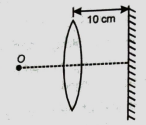A point object O is placed on the principal axis of the convex lens of focal length f = 20 cm at a distance of 40 cm. The diameter of the lens is 10 cm. An eye is placed 60 cm to the right of lens and a distance h below the principal axis. The maximum value of h to see the image is-
1. Zero
2. 2.5cm
3. 5cm
4.10cm
If the wavelength of a ray of light from a source of lights is 3000 in air, then the wavelength of that ray of light in a liquid in which S is placed will be:

(1) 4000
(2) 1500
(3) 9000
(4) 3500
A ray of light incident at an angle i is refracted at angle r into a glass slab of thickness t. The lateral displacement of the emergent ray is
1.
2.
3. t sin (i-r) cos r
4.
Chromatic aberration is absent in
(1) Plano-convex lens
(2) Plano concave lens
(3) Concave mirror
(4) Bifocal lens
For a convex lens of focal length 15 cm the dispersive power of its material is 0.05. The longitudinal chromatic aberration of the lens is
(1) 3.6
(2) 700 cm
(3) 7.5 mm
(4) 1.34
A convex mirror of a focal length f (in air) is immersed in water . Focal length of the mirror in water will be
1. f
2.
3.
4. 4f

1. \(25~\text{m/s}\)
2. \(25\sqrt{2}~\text{m/s}\)
3. \(50~\text{m/s}\)
4. \(50\sqrt{2}~\text{m/s}\)
An object is placed at infinite distance from a concave lens. If m is magnification obtained in the size of the image; then
(1) m=0
(2) m<<-1
(3) m>-1
(4) m<<+1
The diameter of a plano-convex lens is 5 cm and thickness at the centre is 5 mm. If the refractive index of the material of the lens is 1.5, the focal length of the lens is (approximately)
1. 13 cm
2. 15 cm
3. 20 cm
4. 6.35 cm
A point object O is placed at distance 20 cm from a biconvex lens of radius of curvature 20 cm and =1.5. The final image produced by lens and mirror combination will be at

(1) 10 cm from the mirror
(2) 20 cm from lens
(3) -20 cm from lens
(4) -15 cm from the mirror






